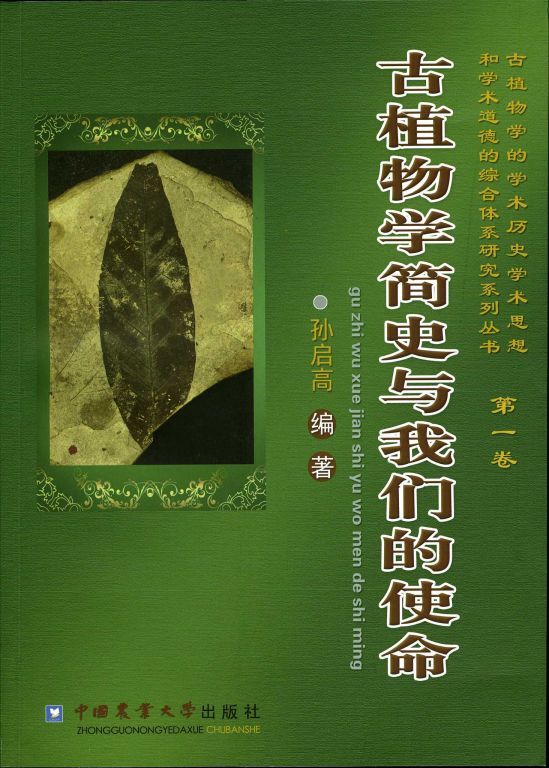博文
A Brief History of Palaeobotany:From the West to the East
|||
《古植物学简史与我们的使命》(第1版)英文目录
A Brief History of Palaeobotany:From the West to the East [1st edition]


By Qigao Sun
Table of Contents
=====================================================
Preface to the first edition
Chapter 1 The definition and roles of palaeobotany as well as the principles of biological approaches of palaeobotanical studies
1.1 Scientific questions, disciplinary scope and national requirements
1.2 The roles of palaeobotany
1.3 The principles of biological approaches of palaeobotanical studies
[Fig.1-1 to Fig.1-8]
Chapter 2 Brief introduction to the palaeobotany in the world
2.1. Fathers of palaeobotany
Kaspar Maria von Sternberg (1761—1838) or
Adolphe-Théodore Brongniart (1801—1876)
2.2 Well-known families for palaeobotany
Henry Potonié (1857–1913) and Robert Potonié (1889–1974)
James Morton Schopf (1911--1978), Thomas James Morton Schopf (1939--1984) and James William Schopf ……
2.3 International Organization of Palaeobotany (IOP)
2.4 International meetings of palaeotany emphasizing the connections with China
2.5 Palaeoboany text books in Europe and North America
[Fig.2-1 to Fig.2-7]
Chapter 3 Palaeobotany in Europe
3.1 German palaeobotany
3.2 British palaeobotany
3.3 Swedish palaeobotany
3.4 Russia palaeobotany
3.5 Polish palaeobotany
[Fig.3-1 to Fig.3-18]
Chapter 4 Palaeobotany in North America
4.1 Brief introduction to American palaeobotany
4.2 Some renowned palaeobotanists in the United States
4.3 Palaeobotanical section of the Botanical Society of America
4.4 Canadian palaeobotany
[Fig.4-1 to Fig.4-6]
Chapter 5 Palaeobotany in Australia
5.1 Australian palaeobotany in the first half of the 19th century
5.2 Australian palaeobotany from 1860s to 1880s
5.3 Australian palaeobotany from the late 19th century to the early 20th century
5.4 Australian palaeobotany from the early 20th century to 1940s
[Fig.5-1 to Fig.5-2]
Chapter 6 Palaeobotany in Asia
6.1 Indian palaoebotany
6.2 The slow rise of Chinese paleoebotany in the world context
6.3 Brief introduction to Chinese palaeobotany
The distribution pattern of palaeobotanical institutions and workers in China
The lists of deceased and retired palaeobotanists in China
The list of palaeobotany academicians and foreign member of the Chinese Academy of Sciences
National Natural Science Foundation of China serves as a lifeline for Chinese palaeobotanists
A review of the palaeobotany text books in Chinese
6.4 Palaeobotanical societies (or associations) and problems in China
General information of the system of academic societies or associations in China
The Botanical Society of China and its palaeobotanical association
The Palaeontological Society of China and its palaeobotanical association
Discussions about the credibility of the palaeobotanical associations in China
6.5 Palaeobotanical meetings in China regarding international significance
[Fig.6-1 to Fig.6-17]
Chapter 7 Chances and Challenges: Make Chinese palaeobotany rise rapidly in the round
7.1 How to establish a stable and high-efficient national system for the Chinese palaeobotanical studies?
How to reform the distribution pattern of palaeobotanical institutions in China?
How to improve the conditions of curated specimens of fossil plants in China?
How to increase the palaeobotanical collections in China?
7.2 How to educate or train up Chinese students to be world-class palaeobotanists?
7.3 How to increase funding channels for Chinese palaeobotanical studies?
7.4 How to improve the credibility of the palaeobotanical associations in China?
7.5 How to initiate active communication and collaboration between Chinese palaeobotanists and foreign colleagues?
[Fig.7-1 to Fig.7-5]
Chapter 8 Summary: “Questions of Palaeobotany” and the missions and challenges of China
Palaeobotanical perspectives for “Joseph Needham’ (1900—1995) Question” and “Hsue-shen Tsien’s (1911—2009) Question”
l Joseph Needham’s Question:“Why was it that despite the immense achievements of traditional China it had been in Europe and not in China that the scientific and industrial revolutions occurred?”
l Hsue-shen Tsien’s Question: “Why do modern Chinese universities or colleges fail to train up talent individuals?”
l “Questions of Palaeobotany”: China’s missions and challenges
Appendices
References
Epilogue
=======================================================
Product Details
Paperback: 169 pages, 63 figures
Publisher: China Agricultural University Press (Beijing, P. R. China); 1st edition (August, 2011)
Language: Chinese
ISBN: 978-7-5655-0390-0
Product Dimensions: 7.3 inches X 10.2 inches (18.5cm X 23.5cm) [16开本]
=======================================================
Related links:
Story of Palaeobotany Series (135):
Copyright information, abstract and contents of the new book-- “A Brief History of Palaeobotany: From the West to the East” [In Chinese]
http://bbs.sciencenet.cn/home.php?mod=space&uid=225931&do=blog&quickforward=1&id=490366
Story of Palaeobotany Series (136):
The preface to the new book-- “A Brief History of Palaeobotany: From the West to the East ” ---Struggle for the rapid rise of Chinese Palaeobotany [In Chinese]
http://bbs.sciencenet.cn/home.php?mod=space&uid=225931&do=blog&quickforward=1&id=490737
(The End)
https://blog.sciencenet.cn/blog-225931-560714.html
上一篇:美国SCIENCE发表深入研究小盗龙Microraptor亮丽羽毛之成果
下一篇:A Brief History of Palaeobotany:From the West ...(2nd ed.)